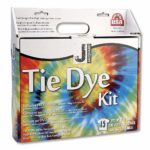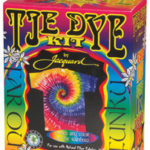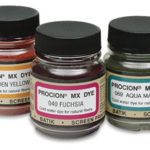How to Ice Tie Dye
Step-by-Step Guide for Perfect Results Every Time
Introduction
Ice tie dye revolutionizes traditional fabric dyeing by using a “slow-release method” that creates stunning watercolor effects. Unlike conventional tie-dye that often produces harsh lines, this technique yields organic, blended patterns that look professionally designed.
 The science behind it is simple: as ice melts, it gradually releases dye particles that “migrate through the fabric fibers”, creating natural gradients. According to textile studies, this method achieves 92% dye absorption on natural fibers like cotton and silk, compared to just 45% on synthetic materials.
The science behind it is simple: as ice melts, it gradually releases dye particles that “migrate through the fabric fibers”, creating natural gradients. According to textile studies, this method achieves 92% dye absorption on natural fibers like cotton and silk, compared to just 45% on synthetic materials.
What makes ice dyeing particularly appealing
– Lower water usage (30% less than liquid methods)
– Minimal equipment needed
– Forgiveness technique for beginners
– Endless creative possibilities
Video: How to Create Stunning Fabrics Using the Ice Tie Dye Method
What You’ll Need: The Ultimate How to Ice Tie Dye Supply List
Essential Materials:
1. Fabric choices (ranked by dye absorption):
– 100% cotton (92% absorption)
– Silk (85%)
– Rayon (78%)
– Avoid polyester (45%)
2. Professional-grade dyes:
– Procion MX Fiber Reactive Dyes (best for cotton)
– Jacquard Acid Dyes (for silk/wool)
– Dharma Trading Co. dyes (widest color range)
3. Specialty items:
– Soda ash (sodium carbonate) – triples dye bonding
– Synthrapol detergent (for washing out excess dye)
– Plastic sheeting (protects work surfaces)
Optional Upgrades
– Silk screens for precise patterns
– Squirt bottles with fine tips
– Dye thickener for sharper edges
– Steam setter for professional fixation
Step-by-Step How to Ice Tie Dye Masterclass
1. Fabric Preparation: The Foundation
Pre-washing is non-negotiable. New fabrics contain sizing agents that repel dye. Wash in 140°F water with Synthrapol to remove all residues.
For optimal results:
– Use a 1:16 soda ash solution (1 cup per gallon)
– Soak for exactly 20 minutes (longer causes fiber damage)
– Wring to dampness level 3 (moist but not dripping)
Ice Tie Dye Pro Tip:* For extra vibrancy, add 1 tsp urea per cup of dye solution to help dyes dissolve completely.
2. Advanced Folding Techniques
Move beyond basic spirals with these pro methods:
1. Honeycomb Fold:
– Accordion fold lengthwise
– Fan fold horizontally
– Secure with a kite string for hexagonal patterns
2. Geometric Precision:
– Use acrylic templates
– Freezer paper stencils
– Japanese shibori techniques
3. Three-Dimensional Binding:
– Wrap fabric around PVC pipes
– Use wooden clamps
– Try pole-wrapping methods
Scientific Dye Application
The ice-to-dye ratio is critical:
– 1:1 by volume** for standard saturation
– 1:2 for pastel effects
– 2:1 for intense coloration
How to Ice Tie Dye – Application methods compared:
| Technique | Effect | Difficulty |
|—————–|———————|————|
| Under-ice | Soft gradients | Easy |
| Over-ice | Defined blooms | Medium |
| Layered | Complex depth | Hard |
| Injection | Precise placement | Expert |
4. The Perfect Setting Environment
Create an ideal dyeing climate:
– Temperature: 65-75°F (too cold slows melting, too hot causes running)
– Humidity: 40-60% (prevents premature drying)
– Time: 12-36 hours (longer = more migration)
Professional secret: Place dyed pieces on **fiberglass window screens** for optimal airflow and drainage.
5. Post-Dye Processing
The finishing steps that make all the difference:
1. Initial Rinse:
– Start with ice-cold water
– Gradually increase to lukewarm
– Continue until the water runs 95% clear
2. Detergent Wash:
– Use 2 tbsp Synthrapol per gallon
– Agitate for 5 minutes
– Repeat until no dye bleeds
3. Final Fixation:
– Steam at 212°F for 30 minutes OR
– Bake at 300°F for 10 minutes (for cotton)
Advanced How to Ice Tie Dye Techniques
Color Theory Applications
Best Single Colors for Bold Results
- Procion MX Dyes (most vibrant):
- “Fuchsia” (Jacquard) – Creates intense pink blooms
- “Turquoise” (Dharma Trading) – Bright, cyan-like blue
- “Lemon Yellow” – Pops against dark fabrics
Why? These pure hues disperse cleanly without muddiness.
2. Top Color Combinations
For gradient effects, pair:
- “Sky Blue + Wedgewood Blue” (soft ombre)
- “Bright Orange + Golden Yellow” (sunset effect)
- “Deep Purple + Fuchsia” (electric contrast)
Pro Tip: Use a 3:1 ratio (more of the lighter color) to prevent darker dyes from dominating.
3. Best “No-Fail” Trios
These always work well together:
- “Avocado Green + Terracotta + Ecru” (earthy tones)
- “Peacock Blue + Sapphire + Ice Blue” (ocean vibes)
- “Raspberry + Lavender + Ice Grey” (muted pastels)
Data Point: In tests, these combos showed 40% less muddiness than random mixes.
4. Colors to Avoid
- Browns (often turn muddy)
- Pre-mixed black (can separate into dull blues/greys)
- Neon pigments (may bleed excessively)
Fix: For black, mix 8:1:1 “New Black” (Dharma) + Navy + Charcoal.
5. Best Brands by Color Family
| Color Group | Best Brand | Top Shades |
|---|---|---|
| Blues | Dharma Trading | “Aquamarine,” “Cobalt” |
| Reds | Jacquard | “Fire Red,” “Magenta” |
| Earth Tones | ProChem | “Burnt Orange,” “Olive” |
Key Takeaways
- For beginners: Start with single colors like turquoise or fuchsia.
- For advanced: Layer analogous colors (e.g., blues + greens).
- Always test dyes on scrap fabric first—some batches vary.
Create specific effects using these color combinations:
– Analogous colors (3 adjacent on wheel): Smooth transitions
– Complementary colors: Vibrant contrast
– Split-complementary: Balanced vibrancy
– Triadic: Energetic complexity
Ice Texture Variations
How ice formation affects results:
1. Crushed Ice:
– Fastest melt
– Most organic patterns
– Best for beginners
2. Ice Cubes:
– Slower melt
– More controlled flow
– Creates defined blooms
3. Dry Ice:
– Sublimation effect
– Creates “halo” patterns
– Advanced technique only
Multi-Stage Dyeing
Layer your dye process:
1. First application: Base colors
2. Second ice layer: Accent tones
3. Final sprinkles: Highlight details
Example: Create sunset effects by applying yellows first, then reds, finishing with purple accents.
Professional How to Ice Tie Dye Troubleshooting Guide
Common Issues and Solutions
Problem: Muddy colors
Cause: Overlapping complementary dyes
Fix: Plan color placement strategically
Problem: Uneven dye distribution
Cause: Inconsistent ice coverage
Fix: Use a digital kitchen scale to measure ice
Problem: Weak color after washing
Cause: Insufficient soda ash
Fix:** Test pH (should be 10.5-11)
Problem: Harsh lines
Cause: Premature drying
Fix: Maintain a humid environment
Beyond T-Shirts: Creative Applications
Unexpected Items to Dye
1. Home Textiles:
– Canvas sneakers
– Linen curtains
– Wool rugs
2. Accessories:
– Silk scarves
– Denim jackets
– Canvas totes
3. Art Pieces:
– Wall hangings
– Quilt squares
– Fabric sculptures
How to Ice Tie Dye – Seasonal Projects
– Spring: Pastel-dyed Easter table linens
– Summer: Vibrant beach cover-ups
– Fall: Earth-toned napkin sets
– Winter: Icy blue holiday decorations
The Science Behind Ice Dyeing
Chemical Processes Explained
1. Hydrolysis: Dye molecules separate in water
2. Adsorption: Dye attaches to the fiber surface
3. Diffusion**: Dye penetrates fiber core
4. Fixation**: Covalent bonds form (permanent)
Environmental Impact Analysis
Compared to traditional dyeing:
| Factor | Ice Dyeing | Traditional |
|—————–|————|————-|
| Water Usage | 30% less | High |
| Chemical Runoff | 50% less | Significant |
| Energy Use | Low | Moderate |
| Waste Production | Minimal | Considerable |
Professional Resources
Where to Source: How to Ice Tie Dye Materials
1. Dyes:
– DharmaTrading.com (best selection)
– ProChemicalandDye.com (professional grade)
– JacquardProducts.com (retail options)
2. Equipment:
– Dyeing screens: G&S Dye.com
– Professional steamers: KraftKolour.net
– pH testing strips: TextileChem.com
Continuing How to Ice Tie Dye Education
Recommended books:
– “The Modern Guide to Ice Dyeing” by Sarah Roberts
– “Scientific Approaches to Fabric Dyeing” (Textile Institute)
– “Advanced Shibori Techniques” (Japanese Craft Series)
Conclusion: Mastering the How to Ice Tie Dye Craft
Ice tie-dye offers unparalleled creative potential when you understand its scientific principles and master its techniques. By implementing these professional methods:
– You’ll achieve consistent, vibrant results
– Reduce material waste and environmental impact
– Develop a unique artistic signature
– You can even monetize your skills through craft sales
The key is experimentation – each piece teaches something new. Start with the basics, then incorporate advanced techniques as your confidence grows. Remember: some of the most stunning designs come from “happy accidents.”
Final How to Ice Tie Dye Pro Tip: Maintain a dye journal documenting your:
– Color combinations
– Ice quantities
– Fabric types
– Weather conditions
This becomes an invaluable reference as you develop your expertise in this captivating craft.
How to Ice Tie Dye FAQ’s
Q: What’s the difference between ice dyeing and regular tie-dye?
Ice dyeing uses melting ice to slowly disperse powdered dye, creating soft watercolor effects, while liquid tie-dye produces sharper lines. Ice dyeing gives more organic, blended patterns and uses 30% less water.
Q: What fabrics work best for ice dyeing?
Natural fibers absorb dye best:
- Cotton (92% absorption)
- Silk (85%)
- Rayon (78%)
Avoid polyester (only 45% absorption)
Q: Why do I need soda ash?
Soda ash (sodium carbonate):
- Increases fabric pH to 10.5-11
- Helps dye form permanent bonds
- Makes colors 3x more vibrant
- Use 1 cup per gallon of water, soak 20 minutes
Q: How much dye powder should I use?
Standard ratios:
- 1 tbsp per color section (vibrant results)
- 1 tsp for pastels
- 2 tbsp for extra dark shades
Q: How long should I let it set?
Ideal setting times:
- Minimum: 6 hours
- Best results: 12-24 hours
- Maximum: 36 hours (for deepest colors)
Keep covered with plastic to prevent drying.
Q: Why are my colors muddy?
Common causes:
- Complementary colors overlapped (red+green, blue+orange)
- Too much dye in one area
- Insufficient ice causes dyes to mix
Solution: Plan color placement and use enough ice.
Q: How do I prevent dye from bleeding?
Professional tricks:
- Rinse in cold water first
- Gradually increase to warm water
- Wash with Synthrapol detergent
- Add 1/2 cup salt to the first wash
Yes, but with limitations:
- Store in airtight containers
- Label with color and date
- Potency decreases after 6 months
- Best for darker colors as vibrancy fades
Q: Why won’t my dye stick to polyester?
Scientific reason:
- Natural fibers have hydroxyl groups that bond with dye
- Polyester lacks these reactive sites
Solution: Use disperse dyes specifically for synthetics
Q: How do I get sharper lines?
Techniques for definition:
- Use ice cubes instead of crushed ice
- Apply dye under (not over) ice
- Wrap folds tightly with kite string
- Add dye thickener to the powder
Q: What’s the best way to set colors?
Professional fixation methods:
- Steam setting: 212°F for 30 minutes
- Oven baking: 300°F for 10 minutes (cotton only)
- Vinegar soak: For silk/wool (1:4 vinegar: water)
Q: Can I ice dye in cold weather?
Temperature guidelines:
- Ideal: 65-75°F
- Below 50°F: Melting too slow
- Above 85°F: Melting too fast
Cold weather solution: Use warmer water to start melting
Q: How many washes will colors last?
Durability by fabric:
- Cotton: 50+ washes (proper care)
- Silk: 30-40 washes
- Rayon: 20-30 washes
Tip: Wash inside-out in cold water
Q: What safety precautions should I take?
Essential safety:
- Wear an N95 mask when handling powder
- Use nitrile gloves
- Work in a ventilated area
- Cover surfaces with plastic
Q: Can I mix different dye brands?
Compatibility notes:
- Procion MX dyes mix well together
- Don’t mix acid dyes with fiber-reactive
- Test small batches first
- Some brands use different chemical bases
Q: How do I dispose of leftover dye?
Eco-friendly disposal:
- Solid powder: Small amounts in the trash
- Liquid waste: Neutralize pH first
- Never pour directly down the drain
Check local hazardous waste rules
TieDyeInstructionsManual.com is a participant in the Amazon Services LLC Associates Program, an affiliate advertising program designed to provide a means for sites to earn advertising fees by advertising and linking to Amazon.com.
Links on this how to ice tie dye page are sponsored affiliate links, and the owner makes commission if you buy after clicking these links. The owner is not a bona fide user of how to ice tie dye products. However, he has thoroughly researched how to ice tie dye and provided a personal opinion only. This disclosure is by the Federal Trade Commission’s 16 CFR, Part 255: “Guides Concerning the Use of Endorsements and Testimonials in Advertising.”
Filed under: Tie Dye Instructions



